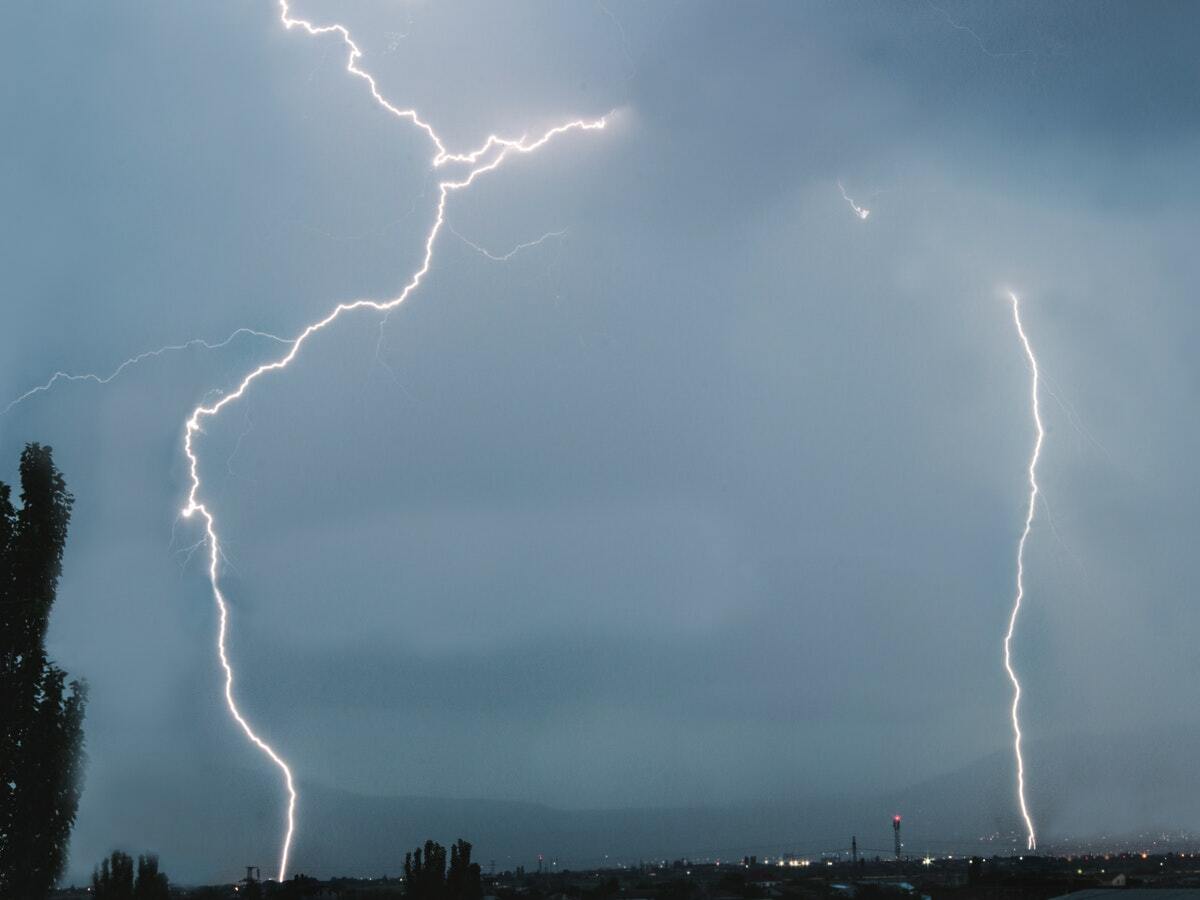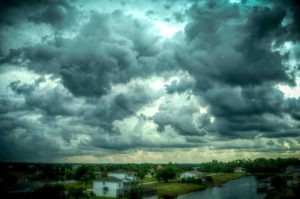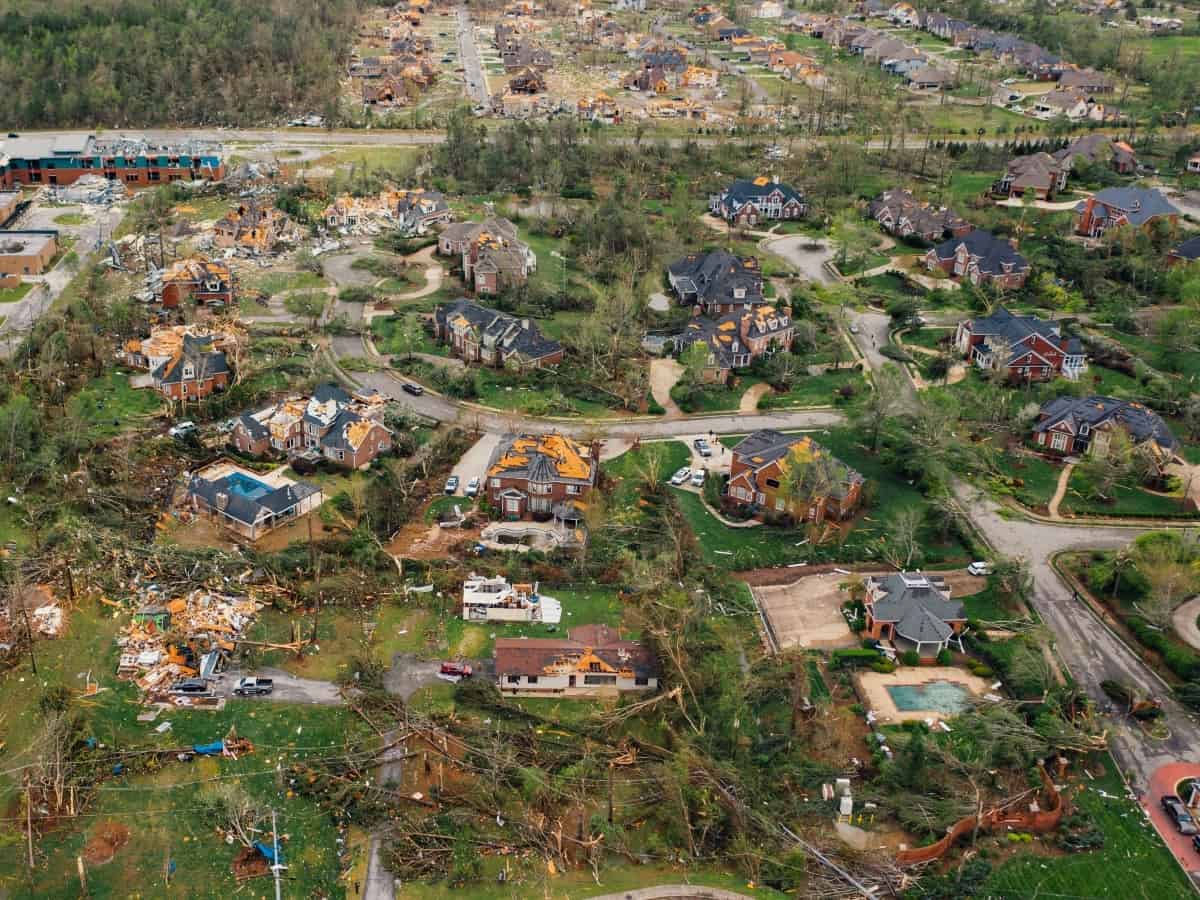Springtime in Texas: a recipe for strong winds, large hails, severe storms and the possibility of a tornado. But what should you do in those high-pressure situations? Before the next storm hits, read our guide to understanding what to do in a tornado and severe weather situation. You’re probably familiar with the 1996 movie Twister, starring Helen Hunt and Bill Paxton. If you have seen the movie, you know that you should absolutely not drive towards a tornado. If you haven’t seen it, save your time and read this guide (unless you enjoy stunning visuals of CGI flying cows).
What’s a Tornado?
A tornado is a column of air that is violently rotating from a thunderstorm onto the ground. A tornado tears everything in its path, picking up dust, debris, trees, cars and parts of houses. Tornadoes are a violent phenomena, known for ripping homes apart with its powerful wind.
There are differing levels to the danger of a tornado through the Enhanced Fujita (EF) scale. The EF scale measures the three second wind gust in miles per hour. These wind gusts come as an indication of the damage the tornado could possess. Here are the ratings of the EF Scale, as labeled as F following the number for intensity:
- F0: 65 to 85 mph causing light damage such as damaged chimneys and trees.
- F1: 86 to 110 mph causing moderate damage such as roofs peeled off, mobile homes overturned, or moving cars.
- F2: 111 to 135 mph causing considerable damage such as roofs torn off framed homes, mobile homes demolished, and cars lifted off the ground.
- F3: 136 to 165 mph causing severe damage such as roofs and walls ripped off well constructed homes, uprooted trees, and cars lifted and thrown.
- F4: 166 to 200 mph causing devastating damage such as leveling homes and ripping houses from weak foundation.
- F5: Over 200 mph causing incredible damage such as strong framed homes leveled and swept away, cars thrown off 100 meters, and trees debarked.

What Causes a Tornado?
There are a few factors that can turn an ordinary spring storm into a devastating tornado. Luckily, these qualifying factors are easy to track through weather data. The main contributor to the formation of tornadoes comes down to the air. Mixing warm, moist air with a dry cold front creates instability in the atmosphere. The denser cold air is pushed over warm air, producing the thunderstorm itself. Then, if the warm air rises above the cold air it creates an updraft. Updrafts can rotate if the winds move sharply in speed and direction.
As the updraft happens, it draws in more and more warm air from the thunderstorm. This causes an increase in rotation speeds. The cold air mixing with the rotation speed creates a strong wind in the atmosphere, producing high energy storms.
From there, the water droplets in the warm, moist air create a funnel cloud. As the funnel cloud continues to grow, it descends from the clouds. The moment it touches the ground, the funnel becomes a tornado.
Signs That a Tornado Could Happen
There are some signs that a tornado is impending or even happening without being able to see it. Unless the tornado has picked up debris, it can be pretty hard to spot! Here are some key signs that the severe weather is actually a tornado:
- A cloud wall or an approaching cloud of debris
- A dark sky, often green in color
- Large hail with the absence of rain
- Eerily calm or still wind before it strikes
- A loud roar, similar to a freight train
- Often strike between 3:00 pm and 9:00 pm.
What’s Tornado Alley?
Have you heard of the term: Tornado Alley? This is commonly referred to areas most likely to be hit with a tornado. This term was introduced in 1953 and spans across several states. These are the states listed as “tornado alley.”
- Texas
- Iowa
- Oklahoma
- Kansas
- Nebraska
- South Dakota
- Colorado
- New Mexico

What’s the Difference Between Tornado Watch and Tornado Warning?
There are two ways that meteorologists will classify tornadoes on the radar. They can put an area as a tornado watch or a tornado warning. These terms are not synonymous, with each meaning bringing a different level of severity and risk. So, what’s the difference?
A tornado watch is issued for weather conditions that are favorable for severe storms and tornadoes to develop. A watch can cover multiple counties, or even the whole state. While this doesn’t mean that there’s an imminent threat, you should still exercise caution and be ready to take cover if the conditions worsen. You can do this by watching the live news stream over weather, keeping up with your favorite weather channel app on your phone, or listening for sirens.
Meanwhile, a tornado warning is issued when a tornado is reported or spotted! A warning should be taken seriously, as tornadoes can be a serious threat to life and property within the path. A warning means to act now. Therefore, if you are under a warning or hear sirens: take cover immediately. If you’re in an area under a tornado warning, listen for city sirens to let you know when to take the threat seriously.
Have a Plan of What to Do in a Tornado
The best way to know what to do in a tornado is to be proactive. Being proactive means having a set plan for what you are going to do in the event of a tornado emergency. Here’s what to do in a tornado, depending on where you are. .
Homes With Basements
Head downstairs and go into an interior room with no windows. This could be a bathroom or a bedroom. Place yourself under a form of sturdy protection like a table or a workbench, and cover yourself with a blanket, sleeping bag or a mattress. You can also use helmets to protect your head and boost survivability rates.
Homes Without a Basement
Go down to the lowest floor, under a stairwell, in the bathroom or any other interior room without windows. Get as low as you can to the ground, crouching with your hands protecting your head. If you have a metal bathtub, get in there to protect yourself against debris. Cover yourself with thick padding like a mattress, sleeping bag or a blanket. This will help protect you from any flying debris or roof failure. It is also recommended to wear a helmet to protect your head.
Apartments and College Dorms
Think of this just like a home without a basement. Get into the lowest floor possible and into an area without any windows to protect yourself from glass and debris. Helmets and thick padding are recommended here, as well.
In an Office Building, Hospital, or Tall Structured Building
Go to an enclosed area in the center of the building without windows. Crouch down to the ground and cover your head. If you’re not sure where to go, head for the stairwells! They are typically a good place to take shelter and allow you to head towards lower levels. But, stay away from elevators. If the power is out, you’re stuck.

Mobile or Manufactured Homes
Get out immediately. Head towards a sturdy building or underground shelter. Think ahead and find a safe place to go during a storm, so you know exactly where to go and what to do if there are tornado watches. Remember, it’s better to be prepared than in trouble.
What To Do In a Tornado If You’re At School
Follow the drill. Each school has a severe weather drill to follow, so listen carefully and know what to do. Chances are, you’ll head to an interior wall or a windowless room. Like other places, crouch down to the ground and protect the back of your head. Use a backpack if it’s near you to add an extra thick layer of protection over your skull. Stay away from windows and large, open rooms (think gyms, auditoriums and cafeterias).
What to Do If You’re In Your Car
Realistically, there isn’t a perfectly safe option if you’re in your vehicle during a tornado. Instead, there’s less risky options. If you can see the tornado and traffic is light, you can try to drive out of the path to find sturdy shelter. If that isn’t possible and you’re stuck in dangerous winds and debris, put the car in park in a safe spot (not in the middle of the road), keep your seatbelt on and protect your head. It’s in best practice to keep your head lower than the window to protect it from any flying debris that could break the glass. If there’s a ditch available, leave your car and get in there, covering your head once again. Do not park your car under a bridge. These spots offer little protection and offer deadly hazards.
In Open Outdoors During a Tornado
Find shelter immediately in a sturdy building. If that isn’t possible, lay down face-down and protect your head. Stay away from trees and cars, as the tornado could move them and harm you.
In a Mall, Grocery Store, Church or Movie Theatre
Move to an interior bathroom, storage area or enclosed space. Stay away from windows and as always, protect your head. If there’s no time to get to the bathroom, get under tables, seats, or pews and cover your head.



